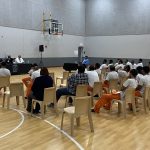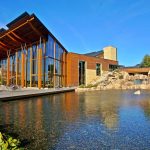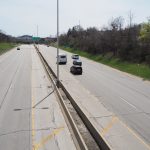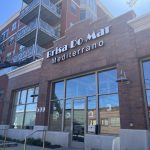An interview with Roy Staab
Kat Murrell interviews Roy Staab in the midst of installation for his retrospective exhibition Four Seasons/Four Corners at Inova/Kenilworth in Milwaukee, Wisconsin. The exhibition opens July 10 and runs through September 27. Roy discusses being broke in Paris early in his career, how installation art is like a dance, working like a scientist, the importance of line, the artist’s structuration mind and figuration mind, and tells Kat the one question he always wishes interviewers would ask him, and a few questions he’s tired of being asked. Watch the video, or read the transcript below.
Roy Staab: Four Seasons/Four Corners
Opening Friday, July 10, 6-9pm
Inova/Kenilworth
2155 N. Prospect Avenue, Milwaukee
July 10 – September 27
KM: Hi, this is Kat Murrell for ThirdCoast Digest. I’m here with artist Roy Staab at the installation of his retrospective exhibition at Inova gallery on Prospect Avenue. Hi, Roy.
RS: Hi, how are you?
KM: Great.
RS: Nice to see you. I see you have your notes.
RS: We can go farther back than that, because this is a retrospective show. I was kind of surprised; we pulled out works from the ’60s when I went to school here or just after school. And then I went to Europe and started making works here and there. I traveled to Morocco and did some works, I did some works in France and in Germany, and some pieces from Germany and from Paris are going to be included in the show. It deals with my research on experimentation, and sometime craziness. Things that no one else has done, or that I do my way.
KM: Are there any surprises for you? I mean, your art career spans, I guess for or five decades now, right?
RS: Let’s try four …
KM: Ok, four decades, but it will be five … But, were there any surprises looking back? At earlier works and bringing them back, reinstalling them, did they give you new perspective on what you’re doing now? How did it feel looking back?
RS: It surprised me how much work I did. I had the ideal to be an artist, didn’t know what an artist is exactly – I knew what an artist is, but it never happened exactly the way I thought. So I worked and I worked, and sometimes I showed the work to somebody and sometimes I didn’t. And I opened up portfolios that no one ever saw, ever saw. And we’re going to see those …
Roy talks about drawing, water, and being out of cash in France
RS: If you look at my old drawings, I had a note on the back of every piece, because I thought making art was like a scientific thing. What did I discover when the piece was dry, what am I going to do in the next piece. And on some of the very early works, there is lots of water, water on thin paper. And the paper –
I had no money. And I was living in France. What did I do? I went to the billboard places and they gave me some very heavy paper and I worked on the backside. And some paper was very thin. And Nicholas [Frank, curator of Inova/Kenilworth] looks at it and says, “Weather Report!” It’s a rock group on the other side of the paper, and he says, “Go to eBay and sell these things, maybe there’s more money for the poster than for the artwork.” (Laughs and shakes finger) Ah, ah ah …
But I experimented, and I had to do my statement. And actually, with that first series that I made in Paris – oh, it was Easter time … 1974 and … I showed it to a gallery and another gallery and I brought it to Durand-Dessert, and he bought two pieces.
I had no place to live. I was going to offer them to the gods in the Seine. And then I saved them, and I have them, and there’s something very fluid about the early works. Sometimes early works are the seed to the next. It is, it was…
The making of “The One”: structure, construction, drawing with eyes and footprints
RS: I’m making the piece so … it’s longer than what it will be, and I make it longer or shorter as I put it together. We’re in the process.
Now, I had to make a perfect oval for inside, there’s a certain line that’s going to be the key-block line. Remember, in printmaking, it’s the last line that holds the whole piece together. This is the oval. And when I designed it, it was going to be two.
You know when you’re working, you’re working physically and you’re working mentally. And then in the process of working … I said no, one is enough, if it flows. And I’m worried about a dead space or quiet area. And that’s the balance of what art is about. It’s very simple. It’s reductive geometry.
KM: It’s so fascinating because it’s so tactile, so natural, so organic looking, but in the complexity of it, there’s this mathematical sort of precision. Like you’re saying a perfect oval, but that’s a tough thing to do.
RS: But nature also has a way to assist you. I measured out in a rough way, well, pretty precisely. And then I wove it and put it together and I put two pieces together to make it, and they were wet. And then I had to nudge it here and nudge it there, and use my eye. I use my eye in my work in many times.
Now we can go to last year; I went to Denmark and made works. The show was called Footprints; we’re going to show two photographs from that. I walked out into the mud at low tide. This is where the river ended at the sea. So I was in mud about this deep, I don’t know – 10 inches. And I slopped around, and with my eye, I was drawing with my footprints. It was the title of the show, no one was going to do it, and I had to try it once and it worked.
I’m like the paintbrush or the stylist when I’m making the work. That’s as big as I am and the gesture I can make.
Reeds and Jute become Line
RS: I did a double-knot, and where’s the end of the string … it’s someplace …
Here it is. When I was working, I worked that way and put it together. It’s a double-knot here and carries on to here, at intervals. I want to make the line as neat as possible.
KM: It’s so lovely how you’ve got the tips in there still.
RS: Here’s the end of one. I do it one way and another way and another way. So I went three at this kind of interval. And that’s enough, that will hold it …
Dance in Space
RS: I think of installation as a dance. Every line has to flow and move in one way to the other, there should be no clumsy movement putting the piece together. It’s kind of an efficiency. And I believe it to be efficient when I’m making the work. So I drew it out, I put it together, and now I have to put it together in another way, but in a clean way so … it comes together right. And a good dance is that way, and I think a good piece of art is this dance in space.
Recalling Nature Belle, and 4 days to finish…
RS: Remember I made that Nature Belle, I have part of it hanging in my backyard. It’s coming apart a little bit; I could put it back together, but I just watch it. Last year I videotaped it again in the wind. I hung it a different way so it moves in another way.
I’m always looking for the next idea, also. So one piece leads to the other. Life is a series of learning experiences.
KM: In this one too, you mentioned that you want to do these waves, wavy forms that you sound very excited about and like, “I have to figure this out … ”
RS: Yeah. And I have four days to get it done. I have four days to really make it look good.
KM: This is probably a bad question for someone to ask an interviewee, but what’s the one question you’ve never been asked in an interview that you wish you were asked?
RS: I could tell you the question that you should never ask – “what’s it for?” That’s one of the scary ones.
You see, there’s a certain kind of mind in making art, there’s a figuration mind and a structured mind. And I’m of the structured mind, I see pattern and form very easily. I go to a play, I watch the structure of the play, listening to the dialogue; the dialogue is the figurative part, but the structure of the dialogue is like what my artwork is about. My work is all about structure and the form. It’s natural to me.
They ask you about your art education. I’m educated. I went to art school for eight years. I went to Layton School of Art, and then Milwaukee Institute of Technology to do some academics, and I went to UWM and got my degree; my degree, my ticket to life. Anyhow, it all came together. And then I had to learn how to make art. It’s about thinking, art is about thinking and getting these ideas assembled and finding out who you are. Sometimes it’s always there. From when I was a child, some basic things are always there.
That was a question that no one ever asked: where does your art come from.
CREDITS
Artist Roy Staab, interviewed on July 6, 2009, in the midst of installation for his retrospective exhibition Four Seasons/Four Corners at Inova/Kenilworth, Milwaukee, Wisconsin, and July 10-September 27, 2009.
Special thanks to Polly Morris, Office of Development & Marketing, University of Wisconsin-Milwaukee Peck School of the Arts for coordinating this interview.
Interview, film, and editing by Kat Murrell.
Art
-
Exhibit Tells Story of Vietnam War Resistors in the Military
 Mar 29th, 2024 by Bill Christofferson
Mar 29th, 2024 by Bill Christofferson
-
See Art Museum’s New Exhibit, ‘Portrait of the Collector’
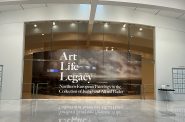 Sep 28th, 2023 by Sophie Bolich
Sep 28th, 2023 by Sophie Bolich
-
100 Years Of Memorable Photography
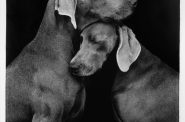 Sep 18th, 2023 by Rose Balistreri
Sep 18th, 2023 by Rose Balistreri



